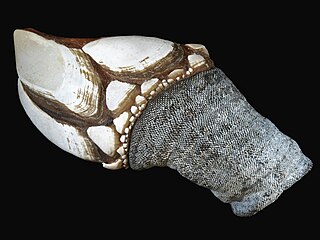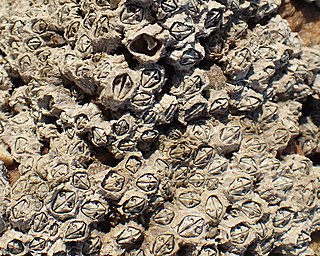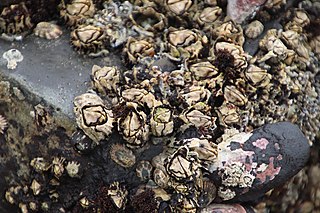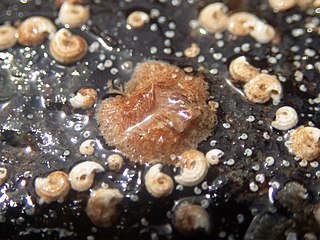
Barnacles are arthropods of the subclass Cirripedia in the subphylum Crustacea. They are related to crabs and lobsters, with similar nauplius larvae. Barnacles are exclusively marine invertebrates; many species live in shallow and tidal waters. Some 2,100 species have been described.

Goose barnacles, also called percebes or turtle-claw barnacles or stalked barnacles or gooseneck barnacles, are filter-feeding crustaceans that live attached to hard surfaces of rocks and flotsam in the ocean intertidal zone. Goose barnacles formerly made up the taxonomic order Pedunculata, but the group has been found to be polyphyletic, with its members scattered across multiple orders of the infraclass Thoracica.

Acorn barnacle and acorn shell are vernacular names for certain types of stalkless barnacles, generally excluding stalked or gooseneck barnacles. As adults they are typically cone-shaped, symmetrical, and attached to rocks or other fixed objects in the ocean. Members of the barnacle order Balanomorpha are often called acorn barnacles.

Sessilia is an unranked clade of barnacles, comprising the barnacles without stalks, or acorn barnacles. They form a monophyletic group and are probably derived from stalked or goose barnacles. Sessilia is divided into two orders. The Verrucomorpha contain two families, Verrucidae and Neoverrucidae, and the remaining 14 families are in the order Balanomorpha.

The Balanomorpha are an order of barnacles, containing familiar acorn barnacles of the seashore. The order contains these families:

Mussa is a genus of stony coral in the family Faviidae. It is monotypic, being represented by the single species Mussa angulosa, commonly known as the spiny or large flower coral. It is found on reefs in shallow waters in the Caribbean Sea, the Bahamas and the Gulf of Mexico.

Eucalyptus angulosa, also known as the ridge fruited mallee or southern ridge fruited mallee, is a eucalypt that is native to Western Australia. The Noongar peoples know the tree as quarral or kwaral.

Lepas pectinata, the small goose barnacle, is a species of goose barnacle in the family Lepadidae.

Jehlius is a genus of star barnacles in the family Chthamalidae. There are at least two described species in Jehlius.

Chthamalus dentatus, the tooth barnacle, is a species of star barnacle in the family Chthamalidae.

Octomeris is a genus of star barnacles in the family Chthamalidae. There are at least three described species in Octomeris.
Tetrachthamalus is a genus of star barnacles in the family Chthamalidae. There are at least two described species in Tetrachthamalus.
Chinochthamalus is a genus of star barnacles in the family Chthamalidae. There is one described species in Chinochthamalus, C. scutelliformis.
Pseudoeuraphia is a genus of star barnacles in the family Chthamalidae. There is one described species in Pseudoeuraphia, P. montgomeryi.
Caudoeuraphia is a genus of star barnacles in the family Chthamalidae. There is one described species in Caudoeuraphia, C. caudata.
Hexechamaesipho is a genus of star barnacles in the family Chthamalidae. There is one described species in Hexechamaesipho, H. pilsbryi.

Microeuraphia is a genus of star barnacles in the family Chthamalidae. There are about eight described species in Microeuraphia.

Verruca is a genus of asymmetrical sessile barnacles in the family Verrucidae. There are about 20 described species in Verruca, around half of them extinct.

Verruca stroemia, the wart barnacle, is a species of asymmetrical sessile barnacle in the family Verrucidae.












